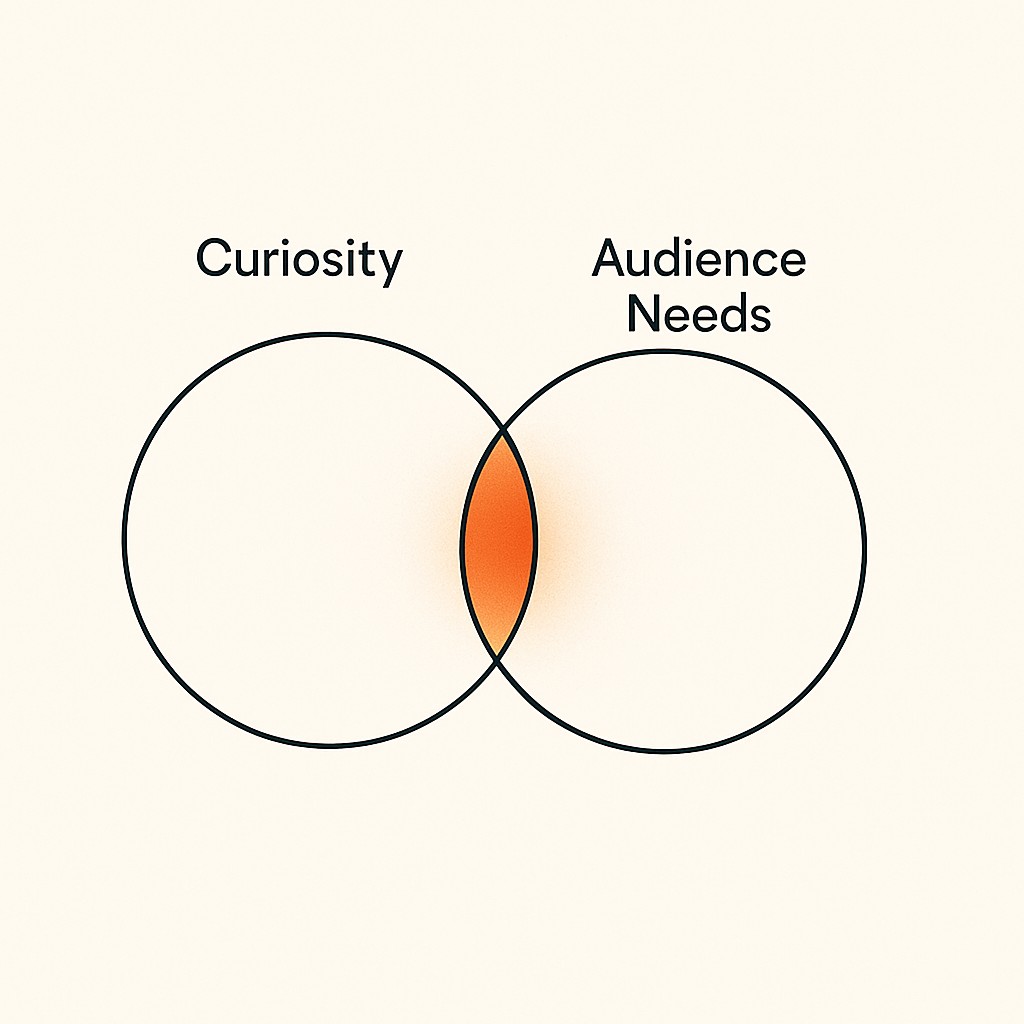Align Content With Audience Without a Relaunch: Small Pivots, Bigger Signals
Align Content With Audience Without a Relaunch: Small Pivots, Bigger Signals

The Moment I Saw What Resonated
I used to write whatever inspired me—leadership insights, mindset tweaks, AI how-tos, even a few movie quotes when they hit just right. Most nights, it felt like progress. Throw ideas out, see what sticks.
Six months ago, I leaned on the belief that regular, thoughtful posting would be enough. I wrote long pieces about resilience, mapped out the nitty-gritty of AI workflows, shared reviews of books that blew my mind. But over time, the pattern was unmistakable. One post format drew saves, comments, and the kind of DMs that actually started conversations. The rest got a like or two and faded away.
That’s when it clicked. I didn’t have a content problem. I had an alignment problem—I hadn’t learned to align content with audience.
The tension sat heavy. If I only wrote what genuinely lit me up, I started wondering if I’d just wander into irrelevance. But if I chased whatever the numbers liked, the urge to keep creating shrank with every post.
The answer is simpler than it feels in the moment. Consistent engagement comes from audience–creator alignment. You publish at the overlap between your curiosity and their needs, once you clarify your niche and outcomes, and if you do that right, you don’t have to scrap everything and start over. There’s a way to pivot, step by step, and let your work actually land where it matters.
What It Actually Means to Align Content With Audience
Alignment isn’t just a buzzword. It’s the real skill of finding overlap, the space where my curiosity meets their need. Instead of narrowing what I talk about, I use an audience first content strategy—spot the patterns they already care about and connect my work to those. You actually hit content market fit when your channel and your content both resonate—Channel User Fit plus Content User Fit unlocks traction across platforms like LinkedIn and blogs.

Now, let’s get practical. A “fit audience” isn’t some mythical group you have to go searching for. It’s the pocket of people who lean in when your themes show up. Thematic gravity is what keeps their attention anchored. It’s the constant pull toward a clear center, so every post feels woven into the same story even if you switch from AI builds on Monday to leadership pitfalls on Thursday. You don’t have to abandon range. You just need thematic gravity.
The unique mix comes from how you frame your ideas, not from what you leave out. And as soon as your posts start orbiting around that center, even the wildest experiments fit together. That’s what stacks up reader trust and makes your work feel coherent without getting repetitive.
I get the doubts. Is this going to take too much time? What if I lose folks who liked the old stuff? Does tightening focus mean I’m sacrificing my creativity? Honestly, I felt each of those. What changed was seeing that clarity wasn’t a constraint. It was an investment. Dialing in meant I spent less energy spinning wheels and got more room to push boundaries inside my chosen lane. Alignment isn’t about losing possibilities. It’s about picking the ones worth doing.
Engagement is a signal, but not all signals are equal. If you’re just checking likes, you’re missing what actually tells you your content fits. Measure meaningful engagement by checking what earns saves, comments, or DMs—not just likes. Those actions mean someone slowed down long enough to think, reach out, or bookmark for later. That’s where the alignment lives for technical work, so build a rhythm for active listening to capture and convert them.
Building alignment isn’t a one-shot relaunch. You pivot content strategy by listening, adjusting, and letting small shifts compound week by week.
Calibrating Toward Alignment, One Post at a Time
Here’s where the shift gets real. You don’t fix misalignment by nuking your feed or rebranding overnight. You just lean in and make small, calibrated changes—one post at a time—and plan reversible content pivots. I started thinking about each week as a step in a longer arc, not a final destination. It’s not about grand gestures. It’s about tiny pivots.
Practically, that looks like this: you pick a single theme for the week, put your post out, and then pay close attention to how it lands. Which telemetry points actually move—saves, comments, DMs? Treat every post like its own experiment, with one clear variable in play while you keep everything else constant. That’s how you actually know what’s working—not by guessing, but by seeing which variable pulls a new signal. It’s direct and actionable, exactly the thinking behind treating each post as its own A/B test and changing one variable at a time to isolate signal—see Sprout Social.
Last October, I decided to dig in on a thematic strength—AI workflows for indie builders using an evidence-first AI workflow. I framed the post around a specific problem: “How do you keep your stack nimble when tools update every quarter?” That framing gave me a clean hypothesis. Would the post spark responses from actual builders, not just curious lurkers? I spelled out the struggle, shared a technical shortcut I use, and actually invited people to share what broke for them in the last update cycle. The payoff wasn’t a flood of likes—it was three detailed DMs, each one a miniature case study.
One builder pointed out a workflow gap I hadn’t considered. Another flagged a resource that filled the blank for their own niche. One clear signal per post, one follower at a time. I kept iterating: tweak the framing, shift the ask, dial up or down the technical detail. If the engagement deepened, I’d know the theme was right. If it fell flat, I just shifted again. But always treat changes as feedback-driven content pivots, not just gut feeling.
That’s the shift. Stop chasing perfect alignment and start chasing awareness. Listen, test, adjust. The clarity compounds. I stopped chasing perfect alignment and started chasing awareness.
Patterns for Real Alignment in Technical Publishing
Let’s get concrete. If you’re a software engineer, start with one razor-sharp theme—say, “developer decision-making under AI constraints.” Each week, share either a technical opinion, a small tutorial, or a build-in-public update, but always loop back to the single question your real audience loses sleep over. Does this AI tool make my workflow faster, or does it pull me into endless debugging? Keep it technical, but solve one anxiety per post. That focus turns a scattered output into a reliable series, and you’ll notice—good engagement builds from that sense of direction, not from covering every topic at once.
If you’re an AI practitioner or indie builder, consider a template themed around “workflow clarity.” Each post isn’t just a quick tip—it’s a puzzle piece: surface a bottleneck (what’s slowing you?), name a choice (what did you try?), and give one actionable fix (what did you change?). String these together so readers can follow your logic in bite-sized steps, building out a series like “Your Move: How to Pivot Without Starting Over.” You’ll see the value build over time—each post nudges them forward, and the series feels like a guide through the mess, not a highlight reel you hope they’ll admire.
Now, here’s how you operationalize depth. Pick a single engagement signal for each post. If you publish a tutorial, track saves. If you frame an opinion, watch for DMs. Whichever signal you choose, let that shape your title, your framing, even the example you use, and use the Net Value gate to decide what ships. It’s direct—one post, one metric, one adjustment at a time.
Worried about losing followers as you get precise? That’s natural, but clarity is the filter. Your fit audience—the ones who actually care—will stick around. Over weeks and months, alignment compounds into consistent engagement, and you’ll find yourself posting with less burnout and more purpose. The rest will drift, and that’s exactly how you build what lasts.
Generate AI-powered drafts aligned to your theme, spin a few variations to A/B test, then post, watch saves or DMs, and align content without relaunch by iterating week by week.
The Payoff of Aligned Publishing
Here’s why alignment actually compounds energy—both for you and the people reading. When your posts reliably serve an audience that truly fits, motivation doesn’t just level off. It builds on itself. You stop feeling that low-level dread before posting and start watching for which parts land. The loop flips. Instead of friction and second-guessing, the feedback starts to work as fuel. There’s even a technical frame for this.
When you create in a context that fuels autonomy, competence, and connection, motivation builds over time—self-determination theory tracks this compound effect. You set up your own flywheel. Each useful post makes it easier to want to write the next, and your audience gets sharper outcomes because you’re finally speaking straight to what matters for them.
So, just to recap—the real move is simple. Publish posts that align content with audience, anchored to one thematic strength. Track your deepest engagement signals, not just surface likes or views. Pivot week by week, testing and refining, but don’t nuke your old feed or try to reinvent everything all at once. Stay in motion, anchored to what’s actually working.
You don’t need to lose your range or cut out everything but your “main topic.” Keep all your interests in play—just let a clear center pull your ideas together, so readers can trust there’s a throughline tying each post to a broader arc. Honestly, when my work felt scattered, I didn’t need fewer interests. I just needed one magnetic core to give all of them context.
Here’s a practical step you can take right now. For your next post, pick one signal to watch, listen closely to how it lands, and adjust for the next round. By next month, you’ll see the difference—consistent engagement follows consistent alignment. Keep tuning, keep posting, and let the feedback work for you.
And if I’m being straight—sometimes the feedback still feels off. A post will miss, or the DMs get weirdly quiet. I haven’t fully figured out the rhythm yet, but the arc keeps bending toward the stuff that matters. I’m fine leaving that open. It’s a problem worth living with.
Enjoyed this post? For more insights on engineering leadership, mindful productivity, and navigating the modern workday, follow me on LinkedIn to stay inspired and join the conversation.
